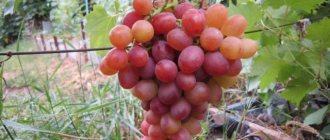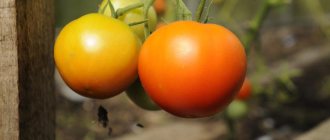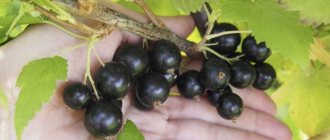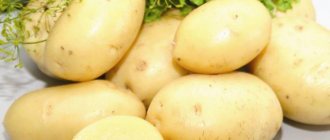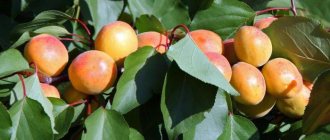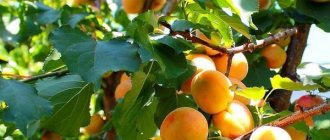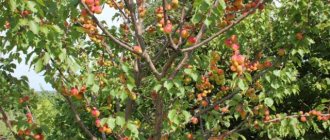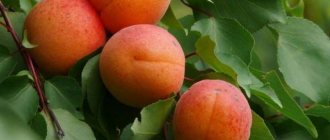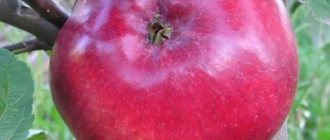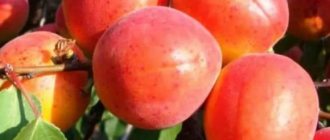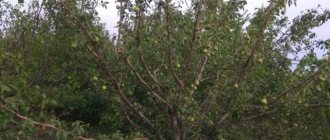History of variety development
Some of the most famous Russian breeders involved in developing new varieties of apricots are the head of the Main Botanical Garden of the Russian Academy of Sciences A. K Skvortsov and breeder L. A. Kramarenko.
For almost half a century, these botanist scientists have been breeding varieties of apricots that could successfully grow and bear fruit in the Central region and not freeze out in winter.
Photo of apricot Tsarsky
It is impossible to say that some of the apricot varieties they bred are the best and others are the worst; each of them is good in its own way. However, the Tsarsky apricot still stands apart; it is not for nothing that it received such a name.
This variety was bred back in 1986.
however, work to improve this fruit tree has been going on for many years.
When breeding Tsarsky apricot, seedlings were freely pollinated, and this procedure was carried out on several generations of trees. The work to improve this apricot hybrid was finally completed only in 2004, when this new apricot was included in the State Register of Russia. The Tsarsky apricot variety was bred specifically for cultivation in the Central region.
Brief overview of Tsarsky apricot - video
Interesting!
Over the time since registration, many summer residents from this region have planted Tsar's apricot seedlings on their plots, and according to their reviews, the best area for growing them is the Moscow region.
Features of the variety
Apricot “Royal” was bred by specialists from the Research Institute of Agrarian Problems in the Republic of Khakassia as a result of breeding work with local, well-proven varieties of apricot. Experts see French roots in the origin of the “Royal” apricot.
Apricot trees of this variety are vigorous, up to five meters high, with a rounded crown. Fruit plantings are characterized by satisfactory winter hardiness and annual abundant fruiting. The minimum yield of mature trees over ten years old is about 45-50 kg.
The fruits are yellow with a slight pink-red blush. The average weight of a commercial apricot is approximately 38-42 g. The pulp of ripe fruits is yellowish-orange in color. The stone separates from the ripe pulp well. The harvest ripens in the mid-early period.
The description of the Tsarsky apricot variety begins in the 80s. Only in 2004 it was entered into the State Register and has already gained popularity among amateur gardeners in the Moscow region and nearby regions. Its creators, A. Skvortsov and L. Kramarenko, breeders of the Main Botanical Garden of the Russian Academy of Sciences, put a lot of effort into breeding this outstanding variety.
Apricot Tsarsky
The fruits are not too large - on average 20 g, oval-shaped, pubescent, dense, the skin is thick, sometimes there is a pink blush. The pulp is tender, juicy, orange in color, sweet and sour taste, with a rich apricot aroma. The seed is small and easily separated from the pulp. The transportability and keeping quality of the fruits are high.
On a note. There are varieties with much larger fruits. For example, apricot Iskra description of the variety: fruits weighing 45 g, juicy, fine-fibered. However, it will not be possible to grow such a miracle north of the Caucasus region.
Apricot Tsarsky: main characteristics and description of the variety
The Tsarsky apricot can grow no more than 4 meters in height. Moreover, its growth in the conditions of the Moscow region is not too high. An average number of lateral skeletal branches extend from the main trunk. In the first few years of life, the degree of growth of lateral shoots remains high due to the fact that a large amount of fertilizer containing nitrogen was used when planting them.
Subsequently, shoot growth slows down and returns to normal. As a result, the shape of the crown of the Royal apricot becomes oval, slightly flattened along the soil surface. Since the crown of this apricot is not too high, it can be pruned 1.5-2 times less frequently than many other apricot varieties.
The color of the smooth bark of the shoots is reddish. The foliage is dark emerald in color, large in size, round in shape, or slightly elongated towards the tips.
Photo of Tsarsky apricot blossoming
The buds begin to bloom on this apricot before the young leaves appear. Flowers are rarely collected in groups, most often they are located singly. They have very short stalks, or the flowers are located directly on the shoots. The color of the petals is white with a pinkish tint, the diameter of the flowers is about 3 cm, the sepals are dark red.
Ripe berries of the Tsarsky variety are small in size, their diameter is up to 3.5 cm, weight is up to 22 g. The fruits are round or oval, slightly elongated. The peel of apricots is of medium thickness, with clearly visible pubescence. Its color is rich yellow; a red blush appears on the side of the fruit that faces the sun and can occupy up to 1/3 of the surface of the fruit.
The pulp of ripe fruits is dense and juicy, has a bright orange color, and the skin peels off easily. The seeds are small in size, no more than 1/10 of the total size of the fruit. It separates easily from the ripe pulp.
Photo of Tsarsky apricot pulp
Ripe apricots of the Tsarsky variety contain many useful substances, in particular vitamins, organic acids, macro- and microelements.
It is these fruits that contain the largest amount of potassium (of all local berries).
100 g of product contains:
- 7.9 g sugars;
- 1.6 g of treatable acids;
- 0.315 g potassium;
- 16.1 g other solids.
Interesting!
The pulp of ripe apricots has a pleasant aroma typical of this fruit tree. And the tasting mark for the taste of the fruits of the Tsarsky variety is 4.5 points.
The harvested crop can be consumed ripe, made into jam, or used for juices or compotes. The fruits are also suitable for freezing.
Photo of apricot jam
Thanks to their thick skin, harvested ripe apricots tolerate transportation well and can be stored in the refrigerator for up to 12-14 days.
The Tsarsky apricot variety has high resistance to drought; this fruit tree can generally do without watering during the summer season, making do only with moisture from passing rains. And if there is no rain, then this apricot can go for more than 2 months without watering.
During the winter, the bark of this tree can easily withstand a series of thaws and frosts without cracking.
Royal apricot is a frost-resistant variety; it tolerates frosts down to -40 degrees Celsius.
Early varieties of apricots
They provide the opportunity to enjoy tasty and healthy fruits where the summer is very short. But plants with early ripening periods are very sensitive to temperature changes and are very afraid of frost. Among the variety of varieties presented, experienced gardeners and summer residents have identified the most worthy of attention and unpretentious in cultivation.
Lel
Apricot Lel is able to please with the first harvest three years after planting the young plant. The crown is very neat in appearance, not spreading, and requires minimal shaping. The height of the tree reaches 3 meters. Very disease resistant, stable yield.
The weight of each fruit of the Lel variety is about 20 grams. At ripeness, the color of apricot becomes rich yellow, closer to orange. The aroma is classic.
The shape of the fruits is slightly flattened. Thanks to the durable skin, they tolerate transportation well and are stored well. The pit is very easy to remove. Suitable for all types of processing and fresh consumption.
Honey
Honey
Fruiting of this variety begins only 5 years after planting a young tree. Resistance to diseases is high, tolerates light frosts. The tree is not tall, which makes caring for it much easier.
The crown is very compact. Productivity is good. The fruits are characterized by classic taste and aroma, medium size. When ripe they are yellow in color with a few red dots on the skin.
Used for purposes such as:
- freezing
- conservation
- making juices
- fresh consumption
Melitopol early
Another excellent low-growing variety, which is still capable of producing a lot of yield. High disease resistance and minimal care are the main advantages of this apricot. In addition, it can easily tolerate light spring frosts.
It begins to bear fruit after three years. The fruits of Melitopol early grow large, thin-skinned, with a medium stone, which is easily separated from the pulp. There are no hard fibers, the pulp is homogeneous.
It is used mainly for fresh consumption; it is not suitable for processing or canning.
Tsarsky
Tsarsky
Despite the fact that this variety is classified as an early variety, full ripening of the fruit occurs in August. It is precisely because of this feature that it is better not to grow it in cold climates. The tree itself is very tall, spreading, its height reaches 4 meters.
Productivity and disease resistance are high. The weight of one fruit is about 23 grams. A ripe apricot has a rich orange or yellow skin with a beautiful blush.
The thick crust ensures long storage: the fruits can easily lie for about two weeks in a cool place. They can be eaten fresh or canned in any way.
Lescore
Lescore
A very worthy variety that tolerates frost well and has good immunity to major diseases. The productivity is very high. The fruits appear 5 years after planting.
The weight of one fruit reaches 93 grams. The stone is easily separated from the pleasant-tasting pulp, and the skin is medium thick. The taste is high, the aroma is classic.
Large apricots cannot help but attract attention; you immediately want to eat them. That is why Lescore is grown mainly for sale and fresh consumption.
Early varieties are not recommended to be grown in regions with short summers, since during the flowering period there may still be frosts and the ovary will simply die from them, and you will never taste the long-awaited harvest.
Pollinator varieties for the Royal apricot
Almost all varieties of apricots bred by Kramarenko and Skvortsov are self-fertile and do not require cultivation of other pollinating fruit trees nearby. And the Tsarsky apricot was no exception - its flowers are pollinated by their own pollen.
The buds bloom on this variety by mid-April, when bees and other pollinating insects do not yet fly, so pollination occurs only by the wind. Since this fruit tree is monoecious, just one apricot in the garden is enough to pollinate it.
But the main feature of the Tsarsky apricot variety is the vulnerability of the buds to spring frosts.
Since this fruit tree blooms in April, most of the flowers may simply die during a sharp cold snap.
Gardeners save them in the following way - during flowering, they cover the tree with plastic film or material folded in half.
This precaution does not interfere with the pollination of flowers, but saves them from low air temperatures. EXCELLENT VARIETY OF APRICOT!
Apricot Northern Triumph
The fruits of the Tsarsky apricot variety begin to ripen in the first ten days of August.
If the weather is cloudy or cold, the ripening of the crop may be delayed by 10-12 days.
Reviews of the Tsarsky variety
...You will also have to graft stone fruits if you want the same variety to grow, because... It’s not entirely clear WHAT will grow from your stone (no one has canceled the splitting of characters, but it occurs in both stone fruits and pome fruits!). Apricot varieties for the Moscow region: the most famous and easiest to obtain is Northern Triumph. But, if you try really hard, find out places and “good” people, then you can get Lel, Zeus, Sea Buckthorn, Tsarsky, etc. They are in bloom now in the Michurinsky Garden of the TSHA.
Alex. Moscow
https://dacha.wcb.ru/index.php?showtopic=636&pid=11229&mode=threaded&start=#entry11229
... I had a variety of apricot “Tsarsky” blooming, planted in an open place near the road and 18–23 meters in a straight line from it, a variety of apricot “Bryansky Early”, planted on the south side of the greenhouse. Despite the fact that he is 1.5–2 years younger, he looks larger. All apricots planted in the open die or grow very slowly. Apricots obtained from Siberia and the Southern Urals performed especially poorly. Of the more than 40–45 vaccinations that survived, as of last year, Royal, Seraphim and Michurinsky. A lot of work was put in and the output was 0. Nothing to brag about.
Bogdan. Saint Petersburg
https://forum.prihoz.ru/viewtopic.php?t=7076&start=75
– The wood is normal, healthy. But the kidneys could freeze in winter. The cross section of the root pruner should be the same light. BUT . NO FEEDING CAN BE MADE. ... THE WEAKER THE ROOTS, THE MORE SENSITIVE TO THE CONCENTRATION OF NUTRIENTS IN THE SOIL. AND NO MINERAL FERTILIZERS IN THE ROOT ZONE OF THE YOUNG SEEDLING!
Oleg, Kyiv
https://dacha.wcb.ru/index.php?showtopic=636&pid=16217&mode=threaded&start=#entry16217
People familiar with the Latin definition of apricot as an Armenian plum should not worry about the harsh climate of Russia. The Tsarsky apricot produces delicious, tender fruits, but the tree itself is winter-hardy and drought-resistant. Truly a royal gift for a gardener.
Apricot Tsarsky - variety yield
The description of the variety given when adding apricots to the State Register indicates the following yield per apricot - 26-40 kg.
But in real life, the amount of harvest can be much smaller. Under unfavorable conditions and the age of trees up to 4-5 years, no more than 8 kg of ripe fruits are collected from one tree.
Important!
The Tsarsky apricot variety begins to bear fruit 3-4 years after the seedlings are planted in a permanent place. But in the first two years from the beginning of fruiting, the yield will be low. And only by the 6-7th year of the tree’s life does fruiting become high.
It should be noted that the fruiting of mature apricots remains stable from season to season. But it may change depending on how correctly gardeners form the crown of the Tsarsky apricot.
Popular varieties
The choice of apricot seedlings must be approached carefully, since it is, after all, a heat-loving plant, and not every variety is suitable, for example, for the Moscow region and especially the northern regions of the country. However, with proper care it is quite possible.
For example, the columnar apricot variety “Prince March” is one of the most productive. It is early ripening and bears fruit already in early August or even at the end of July, starting from the second year after planting on the site. "Prince" does not need a pollinator and has excellent resistance to various diseases and low temperatures.
Reviews from gardeners about this variety are always extremely positive. The harvest collected from 3-5 trees is enough for the average family for both food and supplies. And seedlings of this variety can quite realistically take root even in a cold climate, the main thing is to properly take care of insulating them for the winter and reliably protect the trunk and roots from mice and other rodents. First, it is necessary to cover the trees with improvised means (shavings, spruce branches or dry straw), and then, if possible, cover them with snow as soon as it falls.
Due to their low growth, at first the seedlings can be kept in a greenhouse or even grown in pots. Since apricots bloom in early spring, it may be necessary to protect them from frost during this period. To avoid losing the entire harvest, gardeners recommend setting up a smoke screen.
By following these simple tips, you will be able to grow a beautiful apricot orchard on your plot, which will delight the eye with its appearance and bring a rich harvest in the fall!
Advantages and disadvantages of a fruit tree
The main advantages of the Tsarsky variety include:
- wonderful taste of ripe fruits;
- the harvested crop tolerates transportation well and can be stored in appropriate conditions for up to 12-14 days;
- fruits have a universal purpose;
- high resistance to diseases and pests;
- the Tsarsky apricot variety is frost-resistant and drought-resistant;
- The royal apricot is self-fertile and self-pollinating, so there is no need to plant more than one tree in the garden.
GOOD PEACH VARIETY!
Peach Redhaven
Among the disadvantages of the variety, the following can be noted:
- relatively small fruit sizes;
- small yields in the first years of fruiting;
- The yield of the variety depends on how well the flowers are preserved during the return of spring cold snaps.
Pros and cons of the variety
The Northern Triumph apricot has many advantages, the main ones of which are:
- early ripening of the variety - fruiting can occur already in the 4th season from the moment of planting;
- good berry taste;
- high resistance to frost;
- the fruits are tightly attached to the stalks, so they are not prone to shedding even after full ripening;
- The kernels are edible;
- this variety is self-pollinating;
- high resistance to most diseases;
- at the moment of flowering and fruit ripening, this tree looks very beautiful.
The main disadvantages of this variety are:
- the likelihood of flower buds freezing;
- irregular fruiting.
Diseases and pests
The Tsarsky apricot has high immunity, so it is practically not affected by diseases characteristic of other varieties of this stone fruit. The tree is also not damaged by insect pests.
Even if preventive treatments of the crop are not carried out, the Royal apricot is affected by fungal diseases only in a very rainy season, or in the complete absence of care.
Useful articles:
How to improve soil, its fertility, composition, structure Soil salinity
Care rules and pest control
In order for the tree to grow well and bear fruit, the following measures must be taken:
- water regularly;
- remove diseased and damaged branches;
- whiten the trunk and trunks with lime and copper sulfate in early spring and late autumn.
Despite winter hardiness and frost resistance, care must be taken to protect apricots in winter. To do this, you need not only to trim and whitewash the wood. It wouldn’t hurt to cover it with warm film.
Attention! Some gardeners cover the apricot with roofing felt, but this should not be done so as not to damage the crown.
Near the root, the tree can be wrapped in burlap. Around the Tsarsky apricot you need to dig up to 1-2 m, throwing leaves, humus and peat on top in a layer of up to 20 cm. You can also use straw, reeds or corn stalks for this.
To get a good harvest, carry out preventive treatment against pests
As for pests, the Tsarsky apricot is most afraid of rodents and plum aphids. The tree may also be affected by codling moth, sawfly or spider mite. To protect the plant and the future harvest, even before the buds open, you need to treat the apricot with “Preparation No. 30” or a solution of copper sulfate. Before flowering, you also need to have time to treat the tree with Horus solution. During the growing season, apricot is treated with Karbofos, Fazalon, Zolon, Decis and Sumition.
Apricot is not just very tasty. This is incredibly useful! These sweet fruits help strengthen the heart and blood vessels, relieve asthma attacks, and cleanse the liver and body fluids. Enjoying a luxurious taste and preventing many diseases - this is the “Tsarsky” apricot.
Apricot Tsarsky: planting a fruit tree
When planting Tsarsky apricot seedlings, you should adhere to the basic rules for planting other varieties of apricots in the Central regions of Russia.
Photo of preparing a planting pit for Tsarsky apricot
The Tsarsky variety should be planted permanently in the garden in the spring at the beginning of April or no later than mid-October in the fall.
this stone fruit plant in a flat, sunny place where it will be protected from cold winds.
The lowlands and southwestern slopes are completely unsuitable for growing apricots. The soil requirements are as follows: they must be loose and sufficiently fertile.
Groundwater should not approach the earth's surface closer than 1-1.5 m.
Photo of planting Tsarsky apricot
The Tsarsky apricot tolerates the proximity of dogwood and a number of low vegetable crops well. It is strictly forbidden to plant cherries, walnuts, currants, raspberries, and almost all plants from the Solanaceae and Rosaceae families next to this stone fruit tree.
The distance between these fruit crops should be at least 4 m both in the rows and between the rows. The depth of the planting holes is up to 0.7 m. A stake must be driven into the hole, to which the seedling will be tied. At the bottom of the pit, lay a layer of nutrient substrate consisting of 1 bucket of humus and 1 kg of phosphorus fertilizer.
The tree is placed in the center of the hole, the roots are spread along its diameter, sprinkled with nutrient substrate, the seedling is tied to a stake and soil is added to the soil level. Then the soil is compacted and 2 buckets of water are poured into each tree trunk circle. The graft should be 12-14 cm above ground level.
Planting and caring for apricots - video
Features of planting apricot
One of the main agrotechnical measures, on which the further development of the crop will largely depend, is considered to be planting a seedling. When planting planting material, you should choose the most suitable place and properly prepare the site.
Dates and place of landing
When cultivating apricots in the southern regions, seedlings can be planted in autumn or spring. When growing crops in the middle zone of the country, in particular in the Moscow region, experts advise planting to be carried out in the spring, so that during the summer the plant can adapt well and take root.
For planting, you should choose the most spacious, bright, sunny area, protected from cold winds and drafts. The best option would be a place on a small hill, which, after winter and thawing of the snow, will quickly be warmed up by the sun.
Important! The apricot variety described does not tolerate shading very well, so when planting it, you should avoid the proximity of large trees with a branched crown.
Selection of seedlings
The full development and fruiting of apricot will depend on the quality of planting material. First of all, it is recommended to purchase seedlings in specialized markets or fruit and vegetable nurseries, which guarantees the quality of the crop.
When choosing a material, you need to pay attention to the following aspects:
- Roots . The root shoots of the seedling should be well developed, strong, elastic, white when cut, without signs of dryness, the presence of diseases or parasites, or putrefactive areas.
- Bark. A sign of good planting material is smooth, elastic bark, without dryness or roughness.
- Age. You should choose plants under two years old, since older ones do not take root well and bear fruit much later.
- Graft. The presence of a grafting site indicates the quality and originality of the seedling. Its absence may indicate that the seedling was obtained from a seed, and therefore did not inherit all its parental properties.
Immediately before planting the plant in open ground, its root system is soaked for 30 minutes in a weakly concentrated solution of potassium permanganate, and then in any solution of a growth activator.
Did you know? The use of apricot as a medicine in Russia began during the reign of Tsar Ivan III, the predecessor of Ivan the Terrible.
Site preparation
When planting a seedling in the spring, the planting site is prepared in the fall. To do this, dig a hole measuring 60x70 cm, and the soil extracted from the hole is mixed with humus and minerals.
If the soil on the site is too acidic, then it is deoxidized by adding peat, sand and dolomite flour. In spring, planting work is carried out when the ground has completely thawed, but the buds have not yet begun to bloom on the trees.
Step by step process
The process of planting a Tsarsky apricot seedling is practically no different from planting plants of another variety:
- A small layer of expanded clay, pebbles or broken brick is poured into the planting hole, which will serve as drainage.
- Part of the fertile soil is poured on top of the drainage layer.
- A small mound is made from the soil, into which a wooden peg is inserted to support the seedling.
- The plant is placed on an earthen mound and its root shoots are carefully straightened.
- The seedling is covered with soil so that the root collar remains on the surface.
- The soil near the trunk is compacted a little, watered abundantly, using 20–30 liters of settled, warm water.
- The soil around the plant is mulched with sawdust or peat chips.
Important! Some summer residents practice growing apricots from stones. In this case, the probability of a varietal tree growing is 50%.
Further care for Tsarsky apricot
Caring for this apricot variety is very simple. The main thing is regular watering.
Every 12-14 days, 2-3 buckets of water are poured into the tree trunk circle. The next day after watering, the tree trunk circle is loosened while weeds are removed.
Feeding Tsarsky apricot fruit trees
In the first season, it is not necessary to feed this stone fruit crop if all the necessary fertilizers were added to the holes when planting.
Top dressing for apricot - video
In the following years, the feeding scheme for Tsarsky apricot is simple:
- in the spring, 4 kg of humus, 6 g of nitrogen fertilizer, 5 g of phosphorus fertilizer, and 8 g of potassium salts are added to the tree trunk circles for each square of area.
- At the beginning of the autumn period, 1 bucket of humus is added to each apricot.
PLUM!
Plum Study of Plum Stanley (Stanley)
Pruning the Royal Apricot
The Tsarsky apricot variety requires periodic pruning.
When carrying out this procedure, some of the branches growing inside the crown should be thinned out, and the upper branches should not be allowed to outstrip the lower shoots in growth.
Photo of apricot crown formation
When preparing apricots for winter, it is necessary to prune and whiten the trunk.
If the winter is expected to be cold and snowless, then the tree should be covered with a thin film.
A tree trunk circle with a diameter of 2 meters is mulched with a layer of foliage, straw or peat; its thickness should be at least 19-20 cm.
Photo of whitewashing an apricot trunk
Apricot pruning - video
What kind of care does the culture require?
The Tsarsky variety is undemanding in terms of care, but timely watering, fertilizing, pruning and protection from severe frosts will allow you to grow a healthy, high-yielding tree.
Watering
Apricot tolerates long periods of drought well, but requires periodic watering to grow large volumes of crops. The amount of irrigation depends on weather conditions. During the entire growing season there should be at least three good waterings. Moisture is especially necessary at the end of May for tree growth and fruit formation, two weeks before the crop ripens, and also in preparation for winter.
Feeding fruit trees
In the third year, apricots begin to be fed. Mineral fertilizers are applied annually in the spring. Every four years - organic. During the season, many gardeners spray apricot leaves using potassium and phosphorus-containing fertilizers.
See also
Description and characteristics of the Shalah apricot, relatives and cultivation
Read
Pruning and crown formation
In the first years of life, formative pruning of the tree is carried out, leaving the six strongest and healthiest shoots. All branches located below half a meter from the ground are trimmed.
In the spring, health pruning is carried out, removing all damaged and frozen areas. Due to the peculiarities of the crown, the Tsarsky apricot practically does not require thinning pruning.
Preventative treatments
In rainy summers, apricots can get moniliosis. For treatment, all damaged areas are removed and the tree is sprayed with fungicides. Insecticides are used to control insects.
Preparing a tree for winter
Preparation for winter involves pruning the tree and whitewashing its trunk. Whitewashing will protect against the invasion of insects and rodents. In regions with long periods of low temperatures, apricots are covered with fabric material. Shelter is especially important for young trees.
To protect the roots from freezing, the tree trunk area is mulched with humus at least 20 cm thick.
